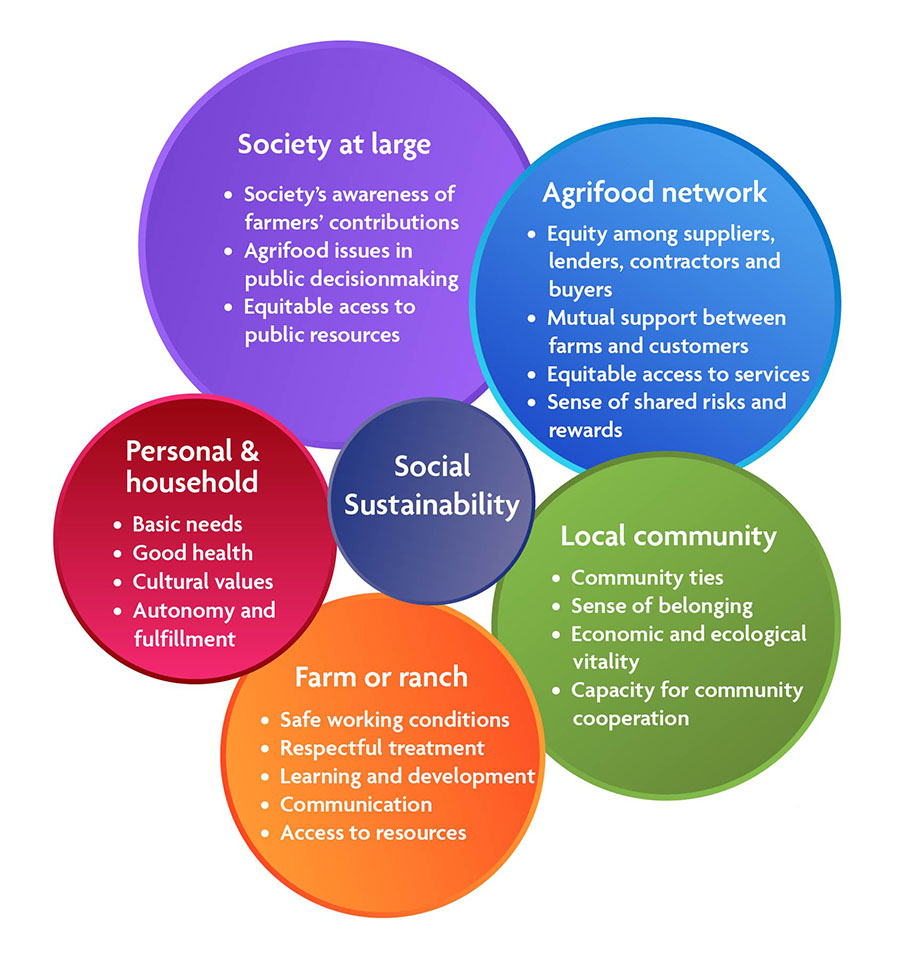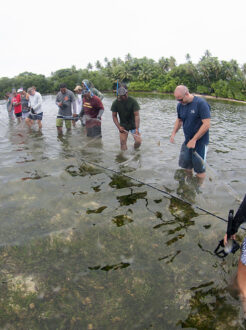What is social sustainability?
Social sustainability involves a focus on the well-being of people and communities. Just as sustainable agriculture promotes long-term ecological health and economic vitality, it also contributes to vibrant communities and regions and satisfying livelihoods for farmers, ranchers, and others in the food system. In many ways, success in one area of sustainability reinforces success in others. Healthy soils, for example, are more productive, leading to both a higher income and increased satisfaction for the farmer and rancher. Similarly, farmers and ranchers can draw on mutually supportive relationships to boost environmental and economic resilience on their farms. To get the most of these benefits, it is important that all aspects of sustainability, including social sustainability, get clear focused attention. The purpose of this brief is to define social sustainability for grantees, reviewers, and other SARE stakeholders and show how it can be described more clearly in SARE projects.
The “social” in social sustainability refers to relationships, both the face-to-face ties people have and the more distant connections forged in the food system. The first thing to note in understanding social sustainability is that there are different levels (or scales) of social relationships. In sustainable agriculture, common levels include:
- Personal and household: Farmer/rancher self-regard and relationships within the household
- Farm or ranch level: Relationships among farmers/ranchers, employees, interns, land-owners, and service providers
- Local community: Ties between farmers/ranchers and the communities to which they belong (including non-farm), including shared cultural identities
- Agrifood network: Ties among farmers/ranchers, customers, suppliers, lenders, and service providers
- Society at large: How farmers/ranchers influence public policy and society’s views of agriculture, food, and sustainability
Some frequent issues arise in SARE related to social sustainability. For example, the resources listed in topic brief “Farm to Table: Building Local and Regional Food Systems” include advice for connecting to local and regional buyers (both household and institutional) and for building the community ties that support urban gardens, farmers markets, and food security projects. Other SARE resources help farmers and ranchers build regional networks, use social media to connect with more customers, promote food justice, and address issues of farm succession and health and wellbeing.
Social sustainability and quality of life
SARE projects put farmers and ranchers at the center. Consequently, social sustainability is often most visible in farmers’ experiences and reflections about quality of life. The examples below can help grant-seekers and reviewers think broadly about the social impacts of research and education projects, beyond the adoption of new methods or an increase in income (though the latter is always welcome). Innovations that prevent injury, afford farmers and ranchers more autonomy in decision-making, or forge stronger and more equitable connections within and beyond the food system would all have a positive impact on social sustainability even without a direct impact on income.

Here are some examples of quality-of-life indicators that might be positively impacted by SARE projects, even those not specifically focused on social sustainability:
- Personal and household: How and to what extent does the project improve farmers’ and their households’ capacity to:
- Meet their basic needs?
- Protect or improve their health and well being?
- Sustain cherished cultural values and practices?
- Feel a sense of autonomy to act creatively according to their social and environmental ethics?
- Feel a sense of personal fulfillment from farming?
- Farm or ranch level: How and to what extent does the project improve:
- The safety and comfort of working conditions for farmers, ranchers, employees, and interns?
- Respectful treatment of employees?
- Intentional learning and professional development for apprentices and interns?
- Communication among farmers and employees, both day-to-day and to identify and resolve issues?
- Access to needed resources and information to enhance sustainable farming?
- Local community: How and to what extent does the project improve:
- Ties between the farm or ranch and its local community?
- Farmers’ and employees’ sense of belonging to the local community?
- The economic and environmental vitality of the community?
- The capacity of the community to cooperate for mutual benefit?
- Agrifood network: How and to what extent does the project improve:
- Fair and transparent negotiations among suppliers, lenders, contractors, and buyers?
- Mutually supportive relationships between farms and their customers?
- Mutually beneficial relationships among farms and ranches?
- Equitable and beneficial access to agricultural services and technical assistance?
- Farmers’ sense of sharing risks and rewards with others?
- Society at large: How and to what extent does the project promote:
- Society’s awareness of the contributions of farmers or ranchers?
- The consideration of agrifood issues in public-sector decision-making?
- Equity in farmers’ and ranchers’ access to public resources?
There are multiple dimensions and measures of social sustainability just like there are for other complex areas like soil health and economic viability. The examples above illustrate some of the common social sustainability benefits of SARE-funded innovations, but anything that improves the capacity of social relationships to promote equity, justice, and a high quality of life counts as social sustainability.
Direct and indirect impacts on social sustainability
Some SARE projects focus directly on social sustainability. Here are some recent projects that grow or improve the social relationships in support of sustainable agriculture:
- A South Carolina project, Farming and Agricultural Recommendations for Mount Pleasant, built partnerships among city planners, residents, farms, and schools to develop a local food economy plan, complete a local food assessment, and recommend changes to the zoning code and other actions. This work strengthened civic engagement and local support for sustainable agriculture as a valued tradition. For example, the town created a special-use area for harvesting sweetgrass for basket-making, an artistic practice of historic and cultural importance to the Gullah community.
- Seeking a direct positive impact on quality of life, a Minnesota farm stress team is using SARE funds to develop and deliver training to federal agency staff, state regulatory staff, Extension representatives, lenders, faith and social organizations, and business people to adapt proven strategies for suicide-prevention, community-level resource engagement, de-escalation, rural adolescent stress, and conflict resolution to the particular realities of farm life.
- The 2019-2020 professional development implementation program for Guam focused on identifying and addressing the factors shaping the island’s food security while forging stronger ties among US-affiliated islands in the Western Pacific. Working at multiple geographic scales, the project supported food security through agroforestry practices, initiating collaborations among farmers and chefs, and strengthening networks of mutual support and the capacity to develop additional WSARE-funded programs.
- A New York-based project, Creating a Black Farmer Commons in Transferring Land, is studying an innovative model of land transfer and collective governance with support from community organizations that promote food sovereignty. Lessons from the project can inform progress toward a more racially just, regenerative and equitable food system.
Some SARE projects do not have social sustainability as their primary purpose, but nevertheless yielded some positive social impacts. Here are some examples:
- At Tanglewood Farm in Indiana, Richard Barnes and Kelly St John developed an elevated cropping system to improve ergonomics and fruit quality for their u-pick strawberries. Their new system increased accessibility and ease of use for customers, expanding mutually supportive ties between the farm and the local community.
- A multi-institution project in Oklahoma is validating soil and plant health interactions within the three-sisters and four-sisters Native American production systems through partnerships between area tribes and University research scientists. In doing so, the project is also supporting food sovereignty and coalescing a network of producers and university researchers “to build a systems research program focused on socially disadvantaged small holder farmers.”
- A 2020 professional development program at the University of the District of Columbia trained agricultural service providers in fruit-growing techniques so that they can better support urban growers seeking to add native fruit trees and fruit-producing bushes to their farms. This kind of project supports farmers’ access to the benefits of perennial crops while also building closer ties between farmers and local consumers as well as between an HBCU and area service providers.
- A farmer/rancher grant project in Idaho developed a new model of herding cattle, one that protects environmentally sensitive areas, reduces contact between cattle and predators, and brings the ecological benefits of grazing to the spaces that most stand to benefit. The model depends on training herders to understand ecological conditions, use GPS technologies, and read cattle behavior to know when to move the herd, and to do all of this on horseback. In that way, the model promotes ongoing professional development, respect for employees’ knowledge and perspectives, and clear communication on the ranch.
Studying social sustainability
There are a number of social science methods for studying social sustainability, including experimental and observational strategies. The choice of study design depends on the research question, data availability, and ethical considerations related to the population and context. In some cases, researchers can quantify the distribution of an outcome or phenomenon across a population. For example, one can assess the impact of a training program by surveying participants both before and after the experience about their knowledge and intentions. The researcher can then measure whether changes in knowledge and behavior are different among sub-groups of participants, such as first-generation and multi-generation farmers/ranchers or white farmers and farmers of color.
Sometimes, though, social or logistical realities mean that quantitative methods are not ethical or practical. In these cases, researchers may chose an observational, qualitative or case-study approach. Observational research focuses less on comparison and more on telling a complete story of a particular case, such as a farm, an organization or project, or a local or regional area. For example, SARE publishes case studies of innovative farms, food hubs, and multidisciplinary research projects, and other interesting projects so that people can use those insights to design their own projects or interventions. Those case studies are grounded in their unique contexts, but they reveal lessons that likely apply to other times and places. Observational research often integrates qualitative and quantitative information to explain the links among events, conditions, interventions, and outcomes.
Larger SARE projects would benefit from including social scientists who have the expertise to determine the level or levels of social relationships likely to be impacted, how those relationships might grow or improve, the best approach to studying those changes, and the plan for recording and analyzing data. Some projects that collect data from people through surveys, interviews, or other methods are considered “human subjects” research and, as such, requires ethics training and prior approval from an Institutional Review Board (IRB). Regional SAREs provide some guidance about IRB approval, sometimes in the call for proposals.
Smaller projects with only a few participants may not be able to include a social scientist or collect much data on social sustainability, but they can still draw on producer, manager or farm worker knowledge to identify how the project or innovation can enhance the social ties that support equity, justice, and a high quality of life in the food system. Something as simple as short, written reflections on the kinds of questions listed above helps SARE and individual researchers track the social impacts of this work and design better studies of and supports for social sustainability.
